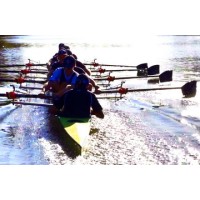Absolute seat movement in crew boat

Did you know that rowers spent an extra 10.5% energy during recovery to overcome inertia? This was found as a ratio of kinetic energy to rower’s Work per Stroke output, and corresponds well to our previous estimation of inertial efficiency (RBN 2010/05).
Those rowers, who changed direction of the seat later at catch, lost three times more energy (up to 18%) compare to “early starters” (6-7%). Therefore, the latter have shown the highest force and power, in absolute numbers as well as the ratio to their erg score, but a part this power was produced by their later teammates and transferred to through the boat-riggers.
These findings were derived using the analysis of absolute seat movement, developed recently for a single scull (RBN 2024/02). In crew boats, a solid boat mass (plus coxswain) interacts with the masses of multiple rowers, which may move differently relative to the boat. An example of a JM8+ was analysed, where synchronization of seat movements relative to the boat was not perfect, as well as of force curves.
At the catch, most of the rowers changed the direction of seat movement significantly later than the stroke and seat 7. This means the timing of the stretcher forces was very different, so the boat acceleration had a distinctive “double-peaking” at the catch.
The absolute seat movements of rowers in this crew clearly reflect differences in timing. As the stroke and seat 7 had the earliest peak of absolute seat acceleration, their absolute velocities were the highest at the catch, when the blades were still out of the water and forces were low. Consequently, when the blades went into the water and forces grew rapidly, other rowers had to apply extra stretcher force to accelerate their mass and pull the handle simultaneously.
This extra stretcher force is transferred through the boat - riggers and push oars through gates, but this additional force is applied to the oars of all rowers, including those who accelerated their seats earlier. Therefore, those who started earlier have to apply less stretcher force, expend less energy, and ultimately produce the highest average force and rowing power.
Therefore, a portion of the force and power measured at the oars of early starters was produced by other rowers in this crew, who accelerated their masses later. We have previously discussed this phenomenon of "power transfer through the boat" (RBN 2012/04) and now analyzed it in more detail.
In this JM8+ sample, the absolute seat travels varied more than two times, ranging from 11 to 24cm, making them 2.1 to 4.7 times shorter than the boat displacement. High correlations were found in this crew:
- r=0.73 between the timing T3 (change of the seat direction at catch) and absolute seat travel (the later – the longer);
- r=0.78 between T1 (start of pushing the stretcher on recovery) and inertial losses (the later – the higher the losses),
- r=-60 between T7 (max. seat velocity) and rowing power (the earlier – the higher power).
Only a part of the stroke cycle with no propulsion (recovery and the beginning of the drive) is analyzed here because the gain of kinetic energy during the drive is a result of propulsion, not energy loss. However, rowers can recuperate a portion of kinetic energy by utilizing the elastic properties of their muscles and ligaments at the catch.
This is a short version of the Newsletter. To access the full text, please subscribe to BioRow membership here: https://biorow.com/membership/
©2024 Dr. Valery Kleshnev



